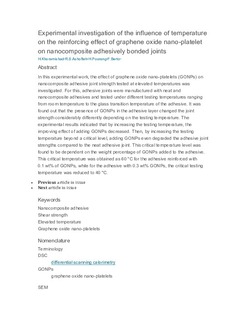| dc.contributor.author | Khoramishad, Hadi | |
| dc.contributor.author | Ashofteh, RS | |
| dc.contributor.author | Pourang, H | |
| dc.contributor.author | Berto, Filippo | |
| dc.date.accessioned | 2019-02-26T13:33:22Z | |
| dc.date.available | 2019-02-26T13:33:22Z | |
| dc.date.created | 2018-11-24T14:06:35Z | |
| dc.date.issued | 2018 | |
| dc.identifier.citation | Theoretical and applied fracture mechanics (Print). 2018, 94 95-100. | nb_NO |
| dc.identifier.issn | 0167-8442 | |
| dc.identifier.uri | http://hdl.handle.net/11250/2587534 | |
| dc.description.abstract | In this experimental work, the effect of graphene oxide nano-platelets (GONPs) on nanocomposite adhesive joint strength tested at elevated temperatures was investigated. For this, adhesive joints were manufactured with neat and nanocomposite adhesives and tested under different testing temperatures ranging from room temperature to the glass transition temperature of the adhesive. It was found out that the presence of GONPs in the adhesive layer changed the joint strength considerably differently depending on the testing temperature. The experimental results indicated that by increasing the testing temperature, the improving effect of adding GONPs decreased. Then, by increasing the testing temperature beyond a critical level, adding GONPs even degraded the adhesive joint strengths compared to the neat adhesive joint. This critical temperature level was found to be dependent on the weight percentage of GONPs added to the adhesive. This critical temperature was obtained as 60 °C for the adhesive reinforced with 0.1 wt% of GONPs, while for the adhesive with 0.3 wt% GONPs, the critical testing temperature was reduced to 40 °C. | nb_NO |
| dc.language.iso | eng | nb_NO |
| dc.publisher | Elsevier | nb_NO |
| dc.rights | Attribution-NonCommercial-NoDerivatives 4.0 Internasjonal | * |
| dc.rights.uri | http://creativecommons.org/licenses/by-nc-nd/4.0/deed.no | * |
| dc.title | Experimental investigation of the influence of temperature on the reinforcing effect of graphene oxide nano-platelet on nanocomposite adhesively bonded joints | nb_NO |
| dc.type | Journal article | nb_NO |
| dc.type | Peer reviewed | nb_NO |
| dc.description.version | acceptedVersion | nb_NO |
| dc.source.pagenumber | 95-100 | nb_NO |
| dc.source.volume | 94 | nb_NO |
| dc.source.journal | Theoretical and applied fracture mechanics (Print) | nb_NO |
| dc.identifier.doi | 10.1016/j.tafmec.2018.01.010 | |
| dc.identifier.cristin | 1634537 | |
| dc.description.localcode | © 2018. This is the authors’ accepted and refereed manuscript to the article. Locked until 11.1.2020 due to copyright restrictions. This manuscript version is made available under the CC-BY-NC-ND 4.0 license http://creativecommons.org/licenses/by-nc-nd/4.0/ | nb_NO |
| cristin.unitcode | 194,64,92,0 | |
| cristin.unitname | Institutt for maskinteknikk og produksjon | |
| cristin.ispublished | true | |
| cristin.fulltext | postprint | |
| cristin.fulltext | preprint | |
| cristin.qualitycode | 1 | |

